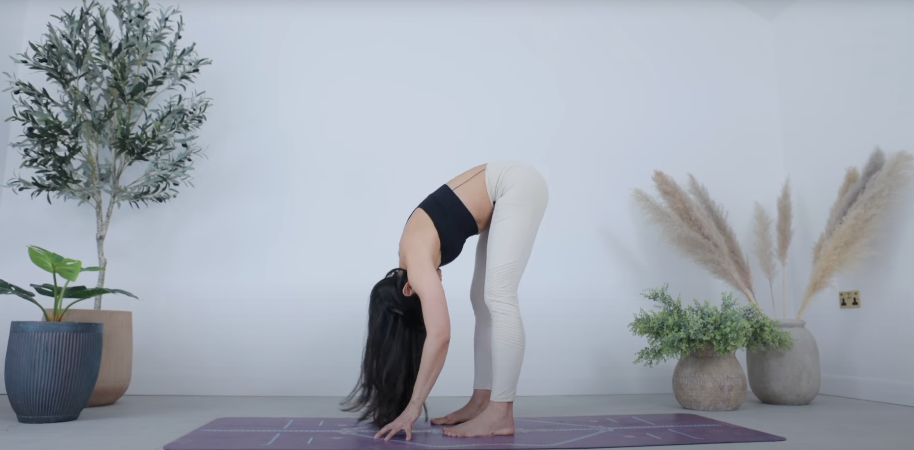10th November 2022
The Origins of Yoga: Part 1

Adiyogi: The True Yoga Pioneer, or Simply Mythical Folklore?
Who is Adiyogi?
Standing as one of the largest known bust sculptures in the world, at 112 feet tall, the Adiyogi Shiva statue is a physical representation of the 112 possible outcomes in our life today that can grant us Moksha (freedom).
The statue has three eyes, with the third said to represent a deep oneness and enlightenment in the spiritual realm. These three eyes also signify that this being is a lord of the past, the present and the future.
And to those who are lucky enough to witness this powerful and remarkable landmark, situated outside the Isha Yoga Centre in Tamil Nadu, they get a true understanding of the importance of this phenomenon in yogic culture. But why is the concept of Adiyogi so important?
From Sanskrit, ‘Adi’ translates to ‘first’ and ‘yogi’ is simply someone who practices, and notably teaches yoga. The saying is brought to life from commonly derived generations of storytelling, through countless cultures, spanning over 15,000 years in total, dating back to its origin, and possibly, the very origins of yoga.
It was told that Adiyogi was the person who brought yoga to life, and birthed the true meaning of it as we know and love today. To Yogic culture, Shiva is not recognised solely as a God, but as Adiyogi – which signifies the sheer magnitude of Yoga as a practice, and rather, a way of life, in Indian culture.
Silence Speaks Louder than Words Ever Can
So the story unfolds as far back as 15,000 years ago, deep within the valleys of the Himalayas. A seemingly enlightened being began expressing pure ecstasy and joy so intensely in a dance, struck so clearly by a profound sense of liberation that locals could not help but be drawn to this act.
They would flock in their thousands to witness up close what was happening before them. After a short while though, this moment of liberated movement transitioned into a period of stillness. Complete and utter motionlessness, in fact. This being, to the naked eye, had abstained from movement. This act went on, and on. Days turned into weeks, weeks turned into months.
Now, if I were to each a class today, and proceeded to sit in complete and utter silence for the entire duration, with no communication, no direction, and no purpose, it would take minutes, possibly shorter, for those in the room to lose interest, lose patience and eventually disperse – not before pleading for a refund! But for Adiyogi, it wasn’t about teaching anything to others, or communicating any knowledge. This stillness, or more accurately, this state of simply being, it felt absolutely necessary for him, and he did not have a care for the people who had initially gathered with such curiosity and wonder.
But, by the time the curiosity had turned into frustration, and the wonder turned into a loss of interest, the locals here had all dispersed to resume their everyday lives. All but seven. These seven individuals were fascinated by the prospect of enlightenment, or to use a better term, and the chosen term for that era, freedom.
What stood before them was someone who did not care for external influence, and did not need any outside stimulation to feel liberated and at peace with life. What they saw, so vividly, almost as if looking through a high definition lens, was a being that was objectively at one with all living things.
Even after Adiyogi exclaimed to these men that this was not a form of entertainment for them, or something novel, the men were desperate to know what Adiyogi knew. To feel what he felt. What did he possess that was different? They were captivated.
So they waited. They would come every morning, maintaining an unwavering awe at what they saw. They would return home in the evenings and wonder throughout the night how this being could go for months on end without food or water, never mind the pleasures we are used to today of work and play.
Spreading the Knowing
Adiyogi would proclaim to these seven individuals that they were not prepared to experience this kind of enlightenment, simply because their level of consciousness was not primed this way, and they were not serious about what he was doing.
But, as time continued to roll on, and the seasons changed, just as the Summer solstice would transition into the Winter solstice – known in yogic culture as Dakshinayana – Adiyogi simply could not ignore how ready and receptive the seven were.
It took 84 years for Adiyogi to become Adiguru, and initiate the process, which took years, of teaching all the facets of yoga and what he knew, onto the soon to be seven sages, and disciples of the guru.
With their newfound enlightenment, the seven celebrated sages (today known as the Saptarishis) were sent to different parts of the world to transmit their knowledge and spread the pioneering message of yoga to everyone who inhabited it. Shiva put different aspects of yoga into each of these seven people, and these aspects became the seven basic forms or schools of yoga:
- Hatha Yoga – yoga of postures.
- Raja Yoga – yoga of self-control.
- Kundelini Yoga – yoga of energy.
- Karma Yoga – yoga of mind.
- Jnana yoga -yoga of mind.
- Bhakti yoga – yoga of devotion.
The teachings the seven sages brought to the world were not simply information on how to breathe correctly, or how to sit still and meditate, but rather, a profound understanding of the makings and functioning of the human system in all of its entirety, on a seemingly scientific level.
The fact that 15,000 years later the teachings live on show the sheer transferability and universality of this practice, and the importance of this story.
Yoga Simply Translates to ‘Unity’,
And it was during the painfully prolonged period of persistent patience, and stillness, that the seven sages experienced with Adiyogi, that they came to understand the groundbreaking importance of how fundamental yoga really is.
To elaborate, yoga is ultimately the power of the essence, of being, of our existence in this world, for now, for the past, and for the future, and to be at oneness with that world. This process is not attached to words or meaning, which is why Adiyogi did not preach anything initially and was so hesitant to enlighten these seven disciples with any knowledge.
The human mind is so deep, so profound, so limitless, that it should not be confined to simply physical boundaries. We are existent on a meta-human level, meaning that we have the ability to go past time and space as we know it. To find true meaning and the purpose of our lives.
This experience can release hidden or trapped trauma, it can unblock what is needed to be unblocked deep in the body, in the mind, or in the spirit. To finally feel liberated from what ails us. This promise is what draws people in their millions to try yoga year on year.
As Sadhguru, the founder and head of the Isha Foundation, explains, “there is a way to be contained in physicality but not to belong to it. There is a way to inhabit the body, but not become the body. There is a way to use your mind in the highest possible way, but still never know the miseries of the mind”.
Transcending Limits
There is so much more to this vessel we operate within on the surface, and crucially, that we limit ourselves to, and find great difficulty navigating and controlling, as we pursue our journey of life. Today we rely so heavily on things outside of ourselves for joy and happiness, for substance that sedates our consciousness, and for the things to keep us busy and functioning in this hectic modern world.
Adiyogi came to us with a message, that to pursue yoga is not simply to practice these facets of yoga, and learn these limbs. But to take the time to journey into ourselves, into the chasms of our mechanisms, and to unravel the real purpose of why we are here.
These limbs act as extension tools for a better understanding of yoga, and they are practiced in different contexts. You may prefer asanas, or the physical postures; maybe pranayama, or the breathing exercises that provide us with a sense of calm and peace; or you may predominantly choose dhyana, the meditations which bring us that step closer to understanding ourselves in the depth.
You may pursue any of the other four limbs: yamas (moral disciplines or restraints); niyamas (observances); pratyahara (sense withdrawal); or dharana (concentration). You may choose to master all of these elements. In doing so, you seek to harness the knowledge of Samadhi, being the eighth and final element – and believed to be the most important, because it stems from the essence of Adiyogi himself.
Samadhi represents the pursuit of enlightenment and the pinnacle of spirituality. It surrounds the knowing of appreciation of the life that surrounds us. Samadhi is not about floating away on cloud nine, it’s more about recognising the light that is always within you, and knowing deeply that we are all at one with nature, with the Universe. This is, simply, what spirituality is, and we all have this innate capacity. It’s nothing mythical. But we just need to find ways to tap into it.
Just how valid are the claims of Adiyogi and his miracle feats?
Now, before arriving at the concluding musings of what Adiyogi’s story and the philosophies born from his legend can do for you and impact your life, even outside of yoga, it’s imperative to address the elephant in the room.
There are many rigidly backed claims dispelling the existence of Adiyogi as such a phenomenon that those including Sadhguru have portrayed him to be. Researchers and anthropologists alike have come to understand that the nature of the stories giving sense to Adiyogi are at times vague, blurred and mixed in with other folklore from different eras. They don’t give enough structure and substance to be taken seriously by academics.
As they rightly point out, ‘mythology’ is simply the act of storytelling to paint a picture of a culture, phenomena, and the origins of certain elements of life and practice. It can thus be plausible that Adiyogi, as a physical being who walked this earth and brought yoga to the people of Asia, was not in fact real, but a fabrication of the creation of yoga.
This is coming from the sense of reference to Purana, the ancient Indian practice of manifesting urban legend to give inspiration and aspiration to those whose hopes for prosperity have been dampened by politics, and a toxic societal fracturing of morals and values. The many myths outlined in Puranic stories provide these people with a sense of worship; an added injection of belief to enrich their lives and improve their outlook.
The ‘real’ Adiyogi, these scholars believe, could actually be dated back to 200 BC, where a yogic leader named Nandhi Natha resided in mount Kailash, and was a guru to Patanjali – someone you will come to know a lot more about throughout this series.
This man took on 8 disciples and sent them to different parts of the world to pass on his messages for all 8 varying aspects of yoga, and the morals by which yoga should be practiced, both on and off the mat.
Now, this still sounds very similar to the more commonly rehearsed legend of Adiyogi and his sages, but perhaps much less glamorised, although most definitely more realistic. The difference here is that millions of avid practitioners and worshippers seeking liberation are not as likely to cling onto the latter story in their quest for hope.
We as humans today have many influences in life but perhaps the strongest of all are shrouded in mystery and seem almost superhuman, as though we could never attain such feats ourselves. These are the heroes we aspire to and listen to most attentively, because the sheer unrealistic aspect to their lives and how they felt, acted and accomplished all that they wished represents the most realistic interpretation of how we envision our lives to pan out.
What We Can Learn from Adiyogi
Whether Adiyogi and the folklore surrounding this phenomenon were indefinitely accurate, or whether this being ever existed at all, there are certainly some take home messages that ring very true for us today, and should be remembered as we continue on our path.
The first, is that many of us, seemingly naturally, fear being still, and sitting with the present moment, because we are uncomfortable with a mind that is not occupied or fretting about the next course of action. We associate stillness as a passive, unproductive, and unhelpful way to be. But, if we reshape this perspective of stillness as simply acceptance, and learn to let go at times in our life, to be with the present moment, we can achieve great things.
The second, is that the sense of connection is vital to us, and we might be losing the importance of that with the rise and dominance of social media. I used to think that success was having a big house, a healthy family, and lots of money – but what are those things good for when you’re not happy or healthy?
It is scientifically proven that when we isolate ourselves and don’t get enough daily social interaction, we put ourselves at a greater risk of various diseases and mental health conditions, yet social media has normalised distant communication – and we are seemingly happy with this trade off of real for virtual connection. Yoga enhances our abilities to feel that connection and oneness again.
The final message is simple, and perhaps the most important of all. Don’t rush. Transforming the way you live through yoga is something that takes place over a sustained period of time, and perhaps your whole life. The point is to fall in love with the journey and the pure bliss and simplicity of finding your true self deep within, through the many pillars of yoga practice.
It will be imperfect, because that’s the way it needs to be, and that’s the only way we can become our best selves. We need the dark with the light, and the light with the heavy. Enjoy the journey, become invested in it, and you will reap the rewards and find happiness and contentment, as you will realise this has always been our natural state.
Related Posts
STAY CONNECTED WITH ME
Subscribe to my newsletter to receive the latest news, updates and offerings.









